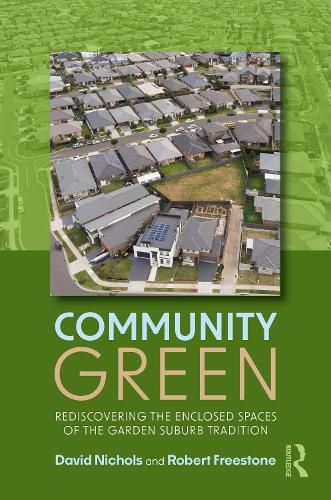Readings Newsletter
Become a Readings Member to make your shopping experience even easier.
Sign in or sign up for free!
You’re not far away from qualifying for FREE standard shipping within Australia
You’ve qualified for FREE standard shipping within Australia
The cart is loading…






Neighbourhood open space ranks highly as a key component in suburban liveability assessments, originating from the development of urban planning as a profession and the proliferation of the garden suburb. Community Green uniquely connects the past, present and future of planning for small open spaces around the narrative of internal reserves.
The distinctive planned spaces are typically enclosed on every side, hidden within residential blocks, serving as local pocket parks and reflecting the evolving values of community life from the garden city movement to contemporary new urbanism. This book resuscitates the enclosed, almost secretive reserve from history as a distinctive form of local open space whose problems and potentialities are relevant to many other green community spaces. In so doing, it opens up even wider connections between localism and globalism, the past and the future, and for connecting community initiatives to broader global challenges of cohesion, health, food, and climate change. This fully illustrated book charts the outcomes and implications of this evolution across several continents, injecting human stories of civic initiatives, struggles and triumphs along the way.
Community Green will be of interest to a wide readership interested in studying, managing and improving the quality of all small open spaces in the urban landscape.
$9.00 standard shipping within Australia
FREE standard shipping within Australia for orders over $100.00
Express & International shipping calculated at checkout
Neighbourhood open space ranks highly as a key component in suburban liveability assessments, originating from the development of urban planning as a profession and the proliferation of the garden suburb. Community Green uniquely connects the past, present and future of planning for small open spaces around the narrative of internal reserves.
The distinctive planned spaces are typically enclosed on every side, hidden within residential blocks, serving as local pocket parks and reflecting the evolving values of community life from the garden city movement to contemporary new urbanism. This book resuscitates the enclosed, almost secretive reserve from history as a distinctive form of local open space whose problems and potentialities are relevant to many other green community spaces. In so doing, it opens up even wider connections between localism and globalism, the past and the future, and for connecting community initiatives to broader global challenges of cohesion, health, food, and climate change. This fully illustrated book charts the outcomes and implications of this evolution across several continents, injecting human stories of civic initiatives, struggles and triumphs along the way.
Community Green will be of interest to a wide readership interested in studying, managing and improving the quality of all small open spaces in the urban landscape.